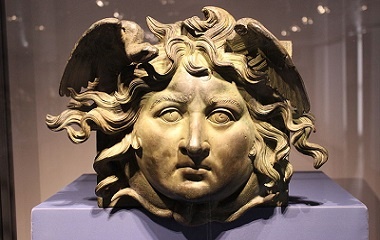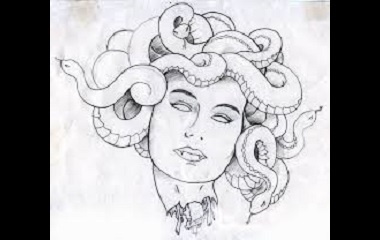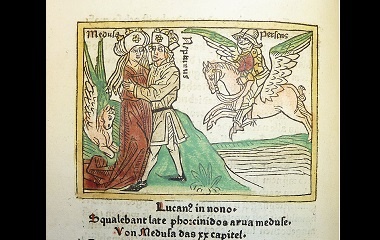Who is Medusa?
One of ancient Greece’s most infamous monsters, Medusa was a snake-haired woman who could turn her enemies to stone with one, deadly glance. Killing this warlike monster was thought to be impossible—and even after she was beheaded, her list of victims kept mounting.
Characteristics
Physical Description
Ask anyone to describe Medusa, and you will hear about the coils of live snakes who hang from her head, in the place of hair. Beyond this horrific detail, her appearance gets fuzzy.
Early Greek poets and historians claim that Medusa was born a monster. She had a hunched, gray body. Feathered wings erupted from her shoulders. Her head was swollen large, and her facial features were stretched into gaping atrocities. Tusks curled over her lips, and her tongue lolled out of her mouth. In some cases, she had a short, coarse beard.
Late Greek and Roman poets brought a more romantic touch to Medusa. They claim she was once a beautiful maiden, but after Poseidon raped her in Athena’s temple, the angry goddess changed Medusa’s hair into snakes. Still, her body and face remained supernaturally beautiful.
Personality
With looks that could, quite literally, kill, Medusa never had the opportunity to make friends. She was hated and dreaded everywhere she went, and she responded with equal venom. Over time, she became “warlike and greatly admired for her manly vigor.” Fighting seemed to be her greatest pleasure in life.
Special Abilities
It’s difficult to say which came first: Medusa’s love of fighting or her talent for it. Certainly, she had so much natural power that she never had to fear her enemies.
Medusa’s body was as strong as a man’s, plus she had her wings to help her launch surprise attacks. The snakes that writhed on her head had a terrible venom, which could kill mortals instantly and cause immortals eternal pain. But she rarely needed these weapons. Anyone who saw her face was turned to stone.
After Medusa’s death, her head retained its power and was used by various heroes and gods as a weapon. The venom from her hair was also used to poison spears and arrows.
Legend
Family
Most sources describe Phorcys and Ceto, rulers of the sea before the Olympic gods arrived, as Medusa’s parents. The pairing is reasonable, since this couple was also responsible for the creation of countless other monsters. Among these were Stheno and Euryale, Medusa’s sisters who were identical in every way except that they were immortal, while she was not. Together, the three sisters were referred to as “the Gorgons.”
After a tryst with Poseidon, the god of the oceans, Medusa became pregnant with twins. She was still pregnant at the time she was killed, and the babies, Pegasus and Chrysaor, sprang from her bleeding body.
Beheaded by Perseus
When King Polydectes fell in love with Perseus’ mother, he needed an excuse to get rid of the young hero, so that he could kidnap and marry the woman he wanted. The king decided to send Perseus on a quest and ordered him not to return until he had seized a Gorgon’s head.
The gods disapproved of Polydectes scheme and decided to help Perseus with his near impossible task. Hermes gave him winged shoes; Hephaestus gave him an enchanted sword; Hades gave him a helm of invisibility; and Athena, who already hated Medusa, gave him the most useful present of all: a mirrored shield.
Armed by four gods, Perseus went to face Medusa, who was rallying an army to attack a village near Lake Tritonus. Perseus, too, brought troops to the fight, but he attacked Medusa alone. Using Hades’ helm and Hermes’ shoes, he snuck into her campsite. Then, by looking into Athena’s mirrored shield rather than into the gorgon’s deadly face, he managed to aim his sword and strike off her head.
After Beheading
Immediately after she was killed, two new creatures burst from Medusa’s mutilated body. These were her children, Pegasus and Chrysaor. Later, Perseus travelled with Medusa’s head as a trophy, and she managed to spawn even more monsters. The poisonous vipers of the Sahara and the dragon-like Amphisbaena each grew from drops of Medusa’s blood.
Meanwhile, Perseus was using her head as a weapon in many battles. He turned both the Titan, Atlas, and the King Polydectes (who was trying to force Perseus’ mother to marry him) into stone. He also used the head to rescue his furutre wife, Andromeda, from a sea monster—then to turn her fiancé into stone, so that she was available for marriage. And he used the head to poison weapons, one of which injured his mentor, Chiron, in a freak accident that led to his death. Eventually, Perseus gave the head to Athena, who attached it to her shield, the aegis.
Cultural Representation
Origin
Not only is Medusa one of Greece’s most famous monsters, she is also one of the most ancient. She first appeared in Homer’s Illiad, which was written in the 8th century BC. From there, her story was told and re-told by premier scholars, including Hesiod, Ovid, and Pindar. Eventually, she was handed down to the Romans, then to Europe, where she was depicted by hundreds of artists, including Benvenuto Cellini, Leonardo da Vinci, Peter Paul Rubens, and Pablo Picasso.
Psychology and Sociology
Over time, Medusa’s legend has become a flashpoint for the discussion of gender in the social sciences. Sigmund Freud himself began the debate, by claiming that Medusa was the ultimate symbol of castration, which young boys might feel drawn to in response to sexual feelings towards their mothers. Feminists fought back by claiming Medusa as a symbol for women’s suppressed rage and power.
Modern Appearances
Today, the fantasy genre is still under Medusa’s spell. She has appeared in popular books and films, including the Percy Jackson series, Clash of the Titans, Doctor Who, and Once Upon a Time. She has also inspired a line of shoes by Versace.
Medusa






No comments:
Post a Comment